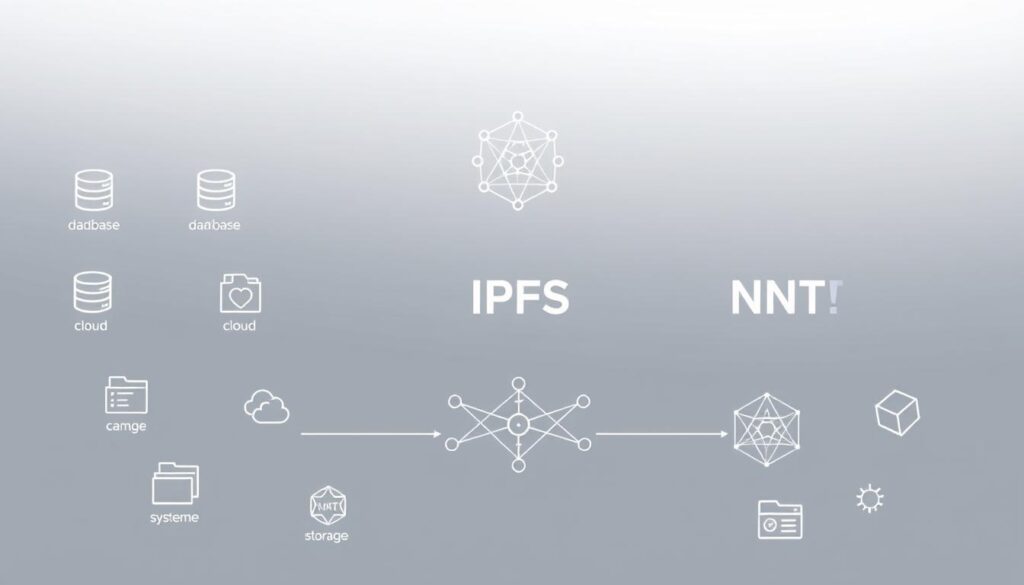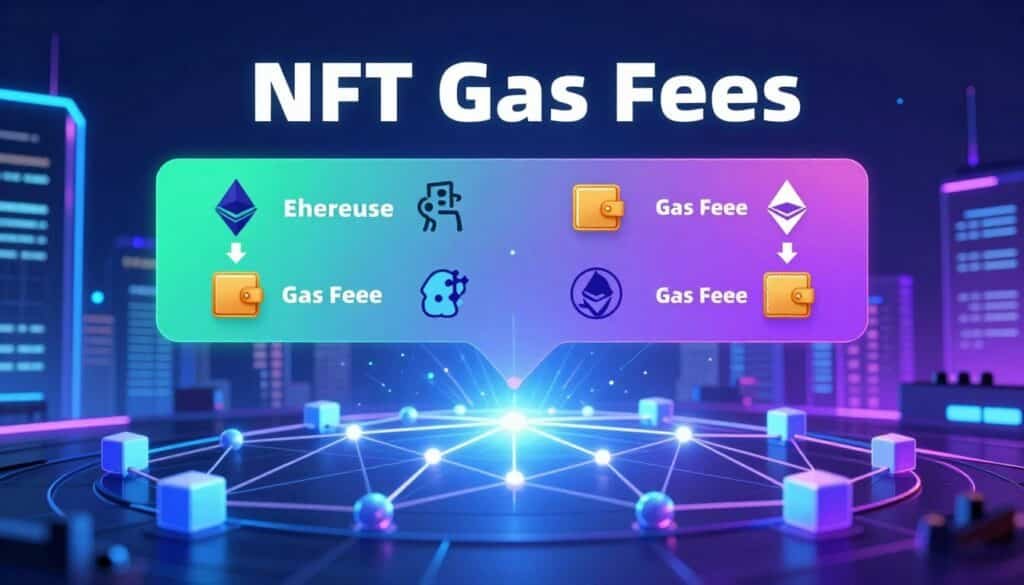Now Reading: NFT metadata and IPFS storage solutions for creators and developers
- 01
NFT metadata and IPFS storage solutions for creators and developers
NFT metadata and IPFS storage solutions for creators and developers

Modern blockchain projects demand reliable systems to preserve digital ownership. Traditional centralized servers create vulnerabilities, as shown when FTX’s collapse left thousands of tokenized assets unusable. When platforms fail, hosted content disappears – turning valuable collections into broken links.
Distributed networks solve this through content-based addressing. Instead of relying on fragile URLs, files get unique cryptographic fingerprints. This approach ensures data remains accessible even if original hosts vanish. Developers save significantly compared to on-chain storage – $1 million for 600MB on Ethereum versus scalable alternatives.
The FTX incident highlights why permanence matters. Token attributes and artwork became inaccessible overnight, erasing user investments. Decentralized protocols prevent this by spreading data across multiple nodes. Creators gain tamper-proof verification while maintaining affordable deployment costs.
Key Takeaways
- Centralized storage risks data loss during platform failures
- Cryptographic file addressing ensures permanent accessibility
- Distributed networks reduce costs by 99%+ versus blockchain storage
- Real-world collapses demonstrate urgency for decentralized solutions
- Content fingerprints prevent unauthorized edits or corruption
Understanding NFT Metadata and Decentralized Storage
Digital collectibles require robust frameworks to maintain their value and accessibility over time. Two critical components enable this: structured descriptive files and decentralized hosting systems. Let’s explore how these elements work together.
What is NFT Metadata?
Metadata acts as a digital passport for blockchain-based assets. Stored in JSON format, it defines properties like names, descriptions, and visual links. Standardized schemas (ERC-721/ERC-1155) ensure marketplaces recognize traits and display them correctly.
An Overview of IPFS and Its Benefits
The InterPlanetary File System uses content fingerprints instead of location-based URLs. Each file gets a unique CID that changes if edits occur. This prevents unauthorized alterations while enabling network-wide access through distributed nodes.
| CID Version | Structure | Primary Use | Compatibility |
|---|---|---|---|
| v0 | 46 characters starting with “Qm” | Legacy systems | Limited browser support |
| v1 | Base32 encoding | Modern projects | Web-friendly gateways |
Version 1 CIDs improve user experiences through better encoding. Data stays available as long as one network participant retains a copy. This eliminates reliance on single servers that might fail or disappear.
Setting Up Your IPFS Environment for NFT Data
Building a resilient storage foundation requires technical precision and understanding of decentralized protocols. This section walks through node configuration and content identification best practices.

Installing and Configuring IPFS Nodes
The Kubo CLI offers developers granular control through terminal commands. Start by initializing your node with ipfs init, then adjust settings like storage limits and peer connections.
| Command | Flag | Function |
|---|---|---|
| ipfs config | –datastore | Set storage type/size |
| ipfs daemon | –enable-gc | Enable automatic cleanup |
| ipfs swarm | –enable-relay | Improve node connectivity |
Generating and Converting CIDs for NFT Content
Always use –cid-version=1 when adding files through CLI. JavaScript developers should specify version options in their ipfs.add methods. For existing v0 identifiers, convert them using web tools to maintain compatibility.
| CID Version | Creation Method | Key Advantage |
|---|---|---|
| v0 | Legacy systems | Backward compatibility |
| v1 | Modern encoding | Gateway support |
Wrap files in directories using wrapWithDirectory to preserve filenames. This creates structured URIs like ipfs://[directory_CID]/filename.png for easy asset management.
Creating and Formatting Compliant NFT Metadata
Interoperability in decentralized systems starts with meticulously formatted descriptive files. Proper structuring ensures digital collectibles display correctly across wallets, explorers, and trading platforms. Let’s examine the blueprint for building universally compatible data frameworks.

Standard JSON Metadata Structures
The ERC-721 schema acts as the foundation for most collections. Required fields include name, description, and image properties pointing to decentralized URIs. Attributes use arrays with paired trait types and values for consistent interpretation.
| Property | Format | Use Case |
|---|---|---|
| image | IPFS URI | Primary visual asset |
| attributes | Trait-value pairs | Rarity calculations |
| external_url | Website link | Additional context |
Ensuring Compatibility with Marketplaces
Leading platforms enforce specific formatting rules. Numeric traits require “display_type” flags for proper sorting. Date characteristics use UNIX timestamps to avoid regional formatting conflicts.
Always test JSON files through validators before deployment. Replace HTTP links with IPFS URIs to prevent broken images during gateway outages. Maintain concise descriptions under 500 characters for optimal mobile display.
Attribute arrays determine collection filtering and rarity rankings. Each entry needs clear trait_type labels and matching values. Avoid special characters that might break marketplace parsers.
Leveraging IPFS URIs and HTTP Gateway URLs for NFTs
Decentralized content access requires strategic link management. Two formats work together: permanent identifiers and temporary access paths. This balance ensures assets stay available across evolving web environments.

Building Canonical IPFS URIs
Content identifiers form the backbone of permanent links. Use the ipfs:// scheme followed by CIDv1 for maximum compatibility. This format tells applications the data lives on distributed networks, not centralized servers.
Modern browsers like Brave automatically recognize these URIs. Developers should prioritize them in smart contracts and metadata files. They remain functional even if initial hosting nodes go offline.
Best Practices for Using HTTP Gateway URLs
Gateway services act as bridges between old and new web protocols. Follow these rules for reliable access:
- Use subdomain-style URLs (cidv1b32.ipfs.dweb.link) for enhanced security
- Rotate between multiple trusted providers like Cloudflare and Infura
- Always pair gateway links with canonical URIs in metadata
| Gateway Type | URL Format | Best For |
|---|---|---|
| Path | https://gateway/ipfs/CID | Quick testing |
| Subdomain | https://CID.ipfs.gateway | Production environments |
Never make gateways your primary reference. They provide temporary access until native IPFS support becomes universal. Update applications periodically as browser capabilities evolve.
NFT metadata and IPFS storage solutions for creators and developers in Practice
Maintaining permanent access to digital assets demands deliberate preservation techniques. Distributed networks automatically clear unused files to save space, creating risks for long-term projects. Strategic pinning prevents this data loss by marking critical content as non-removable.

Essential Pinning Methods
Service-based pinning offers reliability through professional platforms. Pinata provides automated redundancy across global nodes, while Eternum uses decentralized funding models. Both maintain content availability without binding users to specific servers.
Protocol Labs’ free solution supports public collections through Filecoin-backed storage. This combines cost efficiency with enterprise-grade persistence. For private networks, IPFS Cluster coordinates multiple nodes to create custom redundancy rules.
| Service | Redundancy | Cost Model | Best For |
|---|---|---|---|
| Pinata | Global nodes | Monthly plans | High-traffic projects |
| Eternum | Decentralized | One-time fees | Community-driven |
| nft.storage | Filecoin backup | Free tier | New creators |
Temporary caching helps distribute popular files but disappears during network cleanup. Always combine gateway access with permanent pinning. Rotate between services to avoid single points of failure.
Economic planning balances initial costs against long-term value. Hybrid approaches using self-hosted nodes and commercial services often provide optimal reliability. Monitor storage expenses as collections grow.
Wrapping Up: Securing and Scaling Your NFT Data
Building future-proof digital systems requires more than temporary fixes. Decentralized networks offer a robust foundation where data permanence meets cost efficiency. Developers must prioritize cryptographic verification to protect digital assets from platform failures or unauthorized changes.
Adopting best practices ensures collections remain accessible across evolving web environments. Avoid relying on single storage points – hybrid approaches combining blockchain verification with distributed hosting create redundancy. This method scales effectively as projects grow.
Real-world collapses prove centralized storage risks outweigh short-term convenience. Strategic planning balances initial setup efforts with long-term security. Use standardized contracts and test applications rigorously before deployment.
Creators gain peace of mind knowing their work persists through network participation. As the space evolves, these systems will form the backbone of truly owner-controlled digital ecosystems. Start implementing these layers today to future-proof your next project.















